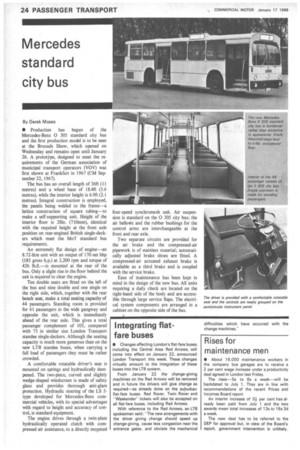Mercedes standard city bus
Page 26

If you've noticed an error in this article please click here to report it so we can fix it.
By Derek Moses • Production has begun of the Mercedes-Benz 0 305 standard city bus and the first production model is to be seen at the Brussels Show, which opened on Wednesday and remains open until January 26. A prototype, designed to meet the requirements of the German association of municipal transport operators (VONT) was first shown at Frankfurt in 1967 (CM September 22, 1967).
The bus has an overall length of 36ft (11 metres) and a wheel base of 18Aft (5.6 metres), while the interior height is 6.9ft (2.1 metres). Integral construction is employed, the panels being welded to the frame---a lattice construction of square tubing—to make a self-supporting unit. Height of the interior floor is 28in. (710mm), identical with the required height at the front axle position on rear-engined British single-deckers which meet the MoT standard bus requirements.
An extremely flat design of engine—an 8.72-litre unit with an output of 170 net bhp (185 gross h.p.) at 2,200 rpm and torque of 426 lb.ft.—is mounted at the rear of the bus. Only a slight rise in the floor behind the exit is required to clear the engine.
Ten double seats are fitted on the left of the bus and nine double and one single on the right side, which, together with the rear bench seat, make a total seating capacity of 44 passengers. Standing room is provided for 61 passengers in the wide gangway and opposite the exit, which is immediately ahead of the rear axle. This gives a total passenger complement of 105, compared with 73 in similar size London Transport standee single-deckers. Although the seating capacity is much more generous than on the new LTB standee buses, when carrying a full load of passengers they must be rather crowded.
A comfortable rotatable driver's seat is mounted on springs and hydraulically dampened. The two-piece, curved and slightly wedge-shaped windscreen is made of safety glass and provides thorough anti-glare protection. Hydraulic steering of the LS 5type developed for Mercedes-Benz commercial vehicles, with its special advantages with regard to height and accuracy of control, is standard equipment.
The engine drives through a twin-plate hydraulically operated clutch with compressed air assistance, to a directly mounted four-speed synchromesh unit. Air suspension is standard on the 0 305 city bus; the air bellows and the rubber bushings for the control arms are interchangeable at the front and rear axle.
Two separate circuits are provided for the air brake and the compressed-air pipework is of stainless material; automatically adjusted brake shoes are fitted. A compressed-air actuated exhaust brake is available as a third brake and is coupled with the service brake.
Ease of maintenance has been kept in mind in the design of the new bus. All units requiring a daily check are located on the right-hand side of the body and are accessible through large service flaps. The electrical system components are arranged in a cabinet on the opposite side of the bus.








































































































